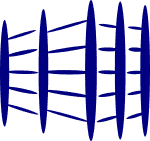Are you an Amazon merchant who wants to know what exactly is happening to your inventory in the warehouse (since there is no visibility of your dropship products)? A warehouse 101 quick guide perhaps?
Are you working in the supply chain industry, but since your job scope does not involve warehouse operations, warehousing is a blackbox to you?
Below is a high level simplified write up of the happenings within a warehouse operations.
There are 6 main basic processes in a warehouse. They are Receiving, Putaway, Picking, Value Added Service (VAS), Packing and Dispatch.

Receiving
Truck Arrival
- Firstly, trucks with inventory come into the compound and park at the dock doors. Unloading of your products process begins.
Pull in to inbound staging area
- Pallets are unloaded from the trucks and pulled into the inbound staging area. These pallets are subsequently place there temporarily for the next action step.
Checks to be done
- Random checks will then be done to these inbound pallets for quality assurance.
Re-palletization
- On certain occasions, these pallets have to be broken down and re-palletized. This can be due to requirements from the customers or requirement from the warehouse to optimize the storage space.
Ready for storage
- Once the checks and re-palletization are done, these pallets are ready to be put into storage.

Putaway
Manual or system determined locations
- Depending on the operations, some warehouses require the operators to determine the location for the putaway of the pallet. For other warehouses, the selection of the putaway locations are done by the system.
MHE (material handling equipment) put pallets to storage medium
- Now that the pallets are ready to be put away, the operators will move these pallets to the respective storage location. This will free up the inbound storage area for other incoming pallets.
Records to be updated in system
- Once the pallets are stored in the designated locations, the system needs to be updated either manually or via RF scan (radio frequency scan) by RF scanners.
Replenishment to pick face
- In situations where a lot of picking are done for certain inventory, and the volume level is low, replenishment from other locations is required.
- This replenishment team can either be the existing inbound team or dedicated standalone team.

Picking
Order flow into warehouse system
- When customers order certain items, be it through the customer service or through an online portal, these orders will flow into the warehouse system. This is where fulfilment of orders begin.
Generate pick list
- From the warehouse system, pick lists/ picking slips are created. These pick lists can be physical copies of papers or directly transmitted into the RF scanners that the pickers are holding onto.
Picker starts picking according to pick list
- Based on the pick list, the picker starts moving to the locations where the products are stored and retrieve these products from the storage locations. Upon completion of the picking, the picker will then proceed to the next location for picking. The cycle continues till all the items in the list are picked.
Bring to staging area
- The picker will then bring the completed picks to an open area known as the staging area. The picked items will be placed here and the picker will move on to complete the next pick list.

VAS (Value Added Service)
Bring items to VAS area
- Certain warehouse operations provide additional services to the customers, and we call Value Added Service (VAS).
- VAS can range from affixing labels, to changing carton boxes, bundling of different items, insertion of leaflets etc.
Bring completed items to staging area
- Upon completion of this activity, the products are then moved back to the staging area.

Packing
Bring items to packing area
- There are also situation where consolidation and packing of items required.
- If shrink wrapping of the pallets is required, the operators will either manually shrink wrap them or bring them to a shrink wrapping machine to complete this action.

Dispatch
Items to move to dispatch area
- The packed products are subsequently moved to the dispatch area.
Sort according to destination routes
- The packed items are segregated according the respective destination routes. This is to help the drivers recognize the stocks to be loaded into the trucks.
- The outbound drivers arrive. Once handover is completed, the items will be loaded into the outgoing trucks.
Dispatch
- Finally, after check completion by security, the drivers will leave the warehouse for dispatch.

You made a good point that planning out the flow of goods is important for warehouse management. I will keep that in mind because I plan to start my own food distribution company someday. I’m currently in the process of knowing more about warehouse doors and their different sizes but ones I get my own warehouse built that will be where the real work will begin.